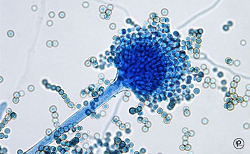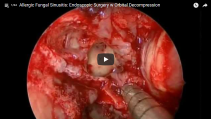To view the original Medscape article, click here
Hello. I am Dr. Tom Chiller, a medical epidemiologist at the Centers for Disease Control and Prevention (CDC). Today I am pleased to speak as part of the CDC Expert Video Commentary Series on Medscape.
As you probably are well aware, CDC, in collaboration with state and local health departments and the US Food and Drug Administration (FDA), is investigating a multistate fungal meningitis outbreak among patients who received contaminated steroid injections.
Several patients have suffered from strokes that are believed to have resulted from their infections. This investigation also includes possible fungal infections associated with injections into peripheral joints, such as a knees, shoulders, or ankles.
To date, all identified cases associated with this outbreak have received at least 1 of 3 lots of preservative-free methylprednisolone acetate (MPA) from the New England Compounding Center (NECC).
The fungal infections we are seeing associated with this outbreak are extremely rare. CDC has convened a panel of the nation’s leading clinical fungal experts who are working with us to ensure that our diagnostic and treatment guidance is appropriate for identifying and treating patients who develop infections.
Today I want to give you an update on where we stand with respect to our clinical guidance.
First, here is what we know: To date, more than 300 cases have been reported to us, which includes 24 deaths across 17 states.
Of cases in which we have identified a fungus, most have been Exserohilum rostratum. One patient has been found to be infected with Aspergillus fumigatus and another with a Cladosporium species. These fungi are common in the environment but were not a recognized cause of meningitis before this outbreak. We are really in new territory when it comes to treatment and management of patients with Exserohilum infection.
CDC and FDA have also confirmed the presence of Exserohilum in 2 of the 3 unopened vials of MPA. We continue to test the third implicated lot of MPA as well as other NECC medications.
Of the approximately 14,000 patients who received injections from 1 of the 3 contaminated lots of MPA, nearly all have been contacted for further follow-up. Among people with meningitis for whom we have clinical information available, the onset of symptoms is typically 1-4 weeks following injection. However, we know that fungal infections can be slow to develop and that there are reports of longer periods of time between injection and onset of symptoms, so we need to monitor these patients for development of signs and symptoms for several months following the injection.
For patients who received epidural or paraspinal steroid injections with medication from any of the 3 recalled lots of MPA, we need to carefully clinically evaluate them. If they have any symptoms consistent with meningitis or posterior circulation stroke, cerebrospinal fluid (CSF) should be obtained for diagnosis unless contraindicated. We also encourage physicians to have a low threshold to obtain CSF in patients with mild signs and symptoms of meningitis because we are aware that some patients in this outbreak have presented with minimal symptoms. When obtaining CSF for diagnosis, we encourage that this be done at a site other than the site used for the steroid injection when possible.
At this time, CDC does not recommend initiation of antifungal treatment in people who received a contaminated steroid injection but who do not have any symptoms or in whom there is no laboratory evidence of infection. However, some patients may be at greater risk than others of developing fungal meningitis. Specific CDC analysis has shown that the greatest risk is in the first 6 weeks after injections.
Clinicians may consider the option of obtaining CSF in patients who received their last injection within the past 6 weeks (42 days) to look for evidence of meningitis before symptoms appear. From our analysis, we have seen that the more time that has passed since the date of the steroid injection, the lower the risk of developing disease.
For patients who are presenting with joint infections, clinicians should collect synovial fluid and/or synovial tissue, either by arthrocentesis or biopsy, and look for evidence of infection.
Let’s shift gears and talk about treatment. If you have a patient who has evidence of fungal meningitis or joint infection, make sure you are following CDC’s treatment recommendations.
At this time, CDC is recommending voriconazole, which is an effective agent for treating infections due to brown-black molds, such as Exserohilum, as well as infections due to Aspergillus species, and has good penetration into the central nervous system.
CDC continues to consult with national experts about treatment options for infections associated with this outbreak. As more information becomes available on patient management, we will continue to update the clinical community.
Please see the links below to stay up to date on the latest CDC guidance.
Finally, because this is an ongoing investigation, we continue to need your help. If you see patients with any suspected adverse events following use of NECC products, please report this to your state health department and FDA’s MedWatch program at 1-800-332-1088 or FDA.gov/medwatch.
Thank you.
Medical and Patient education videos
-
Title
Description
-

Kindly provided by Dr Ronan O’Driscoll and with thanks to Dr P Barber, Bronchoscopy Unit, Wythenshawe Hospital, Manchester. Copyright Dr R. O’Driscoll.
-

This talk on CPA was delivered by Professor David Denning to clinicians and laboratory scientists in Ghana on February 1st 2019, World Aspergillosis Day.
-

Although people usually relate fungi with diseases, Dr. Anne Pringle provides an overview of the vastly diverse and complex world of fungi, and provides examples of the beneficial roles that fungi have on Earth. For example, although some fungi have been associated with devastating infections that threaten harvests every year, other fungi are mutualists needed for the healthy development of plants and animals.
In her second lecture, Pringle explains how one can use a “reverse ecology” approach to describe and characterize different organisms and their habitats, by studying their genes. Her laboratory used this approach to study the origins of the Bay Area Amanita phalloides. Although Amanita phalloides was thought to be an invasive species, historical records were mostly descriptive and hard to use as concrete evidence of the species’ biogeography. Using genetic information, the Pringle laboratory was able to definitively prove that early samples identified as Amanita phalloides in the US are distinct from the European species. They also used molecular data to document the symbiotic associations between Amanita phalloides and plants, proving the efficacy of these approaches to study species that are hard to grow in the lab.
In her third lecture, Pringle provides an overview of convergent interactions, defined as the independent emergence of multi-species interactions with similar physiological or ecological functions. For example, multiple plant lineages have independently evolved interactions with fungi in order to exchange resources and form what are known as mycorrhizal symbioses. To further understand how convergent interactions are formed, the Pringle laboratory studied the evolution of plants that have “pitcher”-like structures as well as the mycorrhizal symbiosis in the Amanitagenus.
-

Although people usually relate fungi with diseases, Dr. Anne Pringle provides an overview of the vastly diverse and complex world of fungi, and provides examples of the beneficial roles that fungi have on Earth. For example, although some fungi have been associated with devastating infections that threaten harvests every year, other fungi are mutualists needed for the healthy development of plants and animals.
In her second lecture, Pringle explains how one can use a “reverse ecology” approach to describe and characterize different organisms and their habitats, by studying their genes. Her laboratory used this approach to study the origins of the Bay Area Amanita phalloides. Although Amanita phalloides was thought to be an invasive species, historical records were mostly descriptive and hard to use as concrete evidence of the species’ biogeography. Using genetic information, the Pringle laboratory was able to definitively prove that early samples identified as Amanita phalloides in the US are distinct from the European species. They also used molecular data to document the symbiotic associations between Amanita phalloides and plants, proving the efficacy of these approaches to study species that are hard to grow in the lab.
In her third lecture, Pringle provides an overview of convergent interactions, defined as the independent emergence of multi-species interactions with similar physiological or ecological functions. For example, multiple plant lineages have independently evolved interactions with fungi in order to exchange resources and form what are known as mycorrhizal symbioses. To further understand how convergent interactions are formed, the Pringle laboratory studied the evolution of plants that have “pitcher”-like structures as well as the mycorrhizal symbiosis in the Amanitagenus.
-

Although people usually relate fungi with diseases, Dr. Anne Pringle provides an overview of the vastly diverse and complex world of fungi, and provides examples of the beneficial roles that fungi have on Earth. For example, although some fungi have been associated with devastating infections that threaten harvests every year, other fungi are mutualists needed for the healthy development of plants and animals.
In her second lecture, Pringle explains how one can use a “reverse ecology” approach to describe and characterize different organisms and their habitats, by studying their genes. Her laboratory used this approach to study the origins of the Bay Area Amanita phalloides. Although Amanita phalloides was thought to be an invasive species, historical records were mostly descriptive and hard to use as concrete evidence of the species’ biogeography. Using genetic information, the Pringle laboratory was able to definitively prove that early samples identified as Amanita phalloides in the US are distinct from the European species. They also used molecular data to document the symbiotic associations between Amanita phalloides and plants, proving the efficacy of these approaches to study species that are hard to grow in the lab.
In her third lecture, Pringle provides an overview of convergent interactions, defined as the independent emergence of multi-species interactions with similar physiological or ecological functions. For example, multiple plant lineages have independently evolved interactions with fungi in order to exchange resources and form what are known as mycorrhizal symbioses. To further understand how convergent interactions are formed, the Pringle laboratory studied the evolution of plants that have “pitcher”-like structures as well as the mycorrhizal symbiosis in the Amanitagenus.
-

Medical student, Anastasiya Kret, tells us about her experiences of an eight week summer scholarship funded by the MRC Centre for Medical Mycology where she traveled from Aberdeen to Germany to work in the Department of Pathogenicity Mechanisms at the Hans Knöll institute in Jena. Find out more about the training opportunities within the MRC Centre for Medical Mycology here.
-

Management of allergic and chronic pulmonary aspergillosis. Masterclass
part 3: Disease Progression and approaches to therapy by Prof David Denning. Presented at 5th Advances Against Aspergillosis conference in Istanbul January 2012. -

The Aspergillus Website maintains a collection of Youtube videos on fungal sinusitis. To access the whole collection click on the link at the top of the image above.

